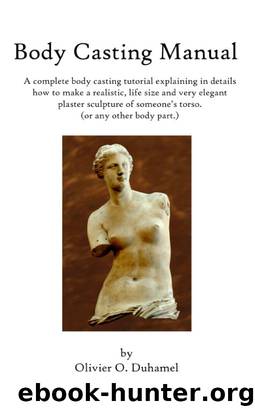Body Casting Manual by Olivier Duhamel

Author:Olivier Duhamel
Language: eng
Format: epub
Tags: art, sculpture, casting, molding, lifecasting, bodycasting, moldmaking, alginate, plaster, pregnant belly, baby hands, lifesize sculpture
Publisher: Olivier Duhamel
Casting hands – Wax mold
The second method for casting hand involves building a mold in wax instead of alginate. It is a cheaper method as the wax can be reused. It will not capture as much details as alginate will.
It consists of repeatedly dipping the hand to be cast in a batch of molten wax until a wax skin of about ½ centimeter (1/8 in) has be build. The hand must then glide out of the mold in which plaster or other casting material can be poured.
A low temperature wax must be used for this purpose. Paraffin wax is liquid at 40°C (104°F). This is a temperature that is very comfortable and will not burn. Paraffin wax is often sold as preserving wax but the cheapest source is candle making wax sold in most craft stores.
You can also use wax specially formulated for skin casting such as Polytec’s Poly Skin Wax.
You will need about 3kg (6lb) of paraffin wax.
The procedure is as follows.
Melt all your wax. Wax is very flammable. The temperate above which it will spontaneously catch fire (flash point) is very low. Never melt it over a direct flame such as a gas burner. Always use either an electric frying pan or a crock-pot equipped with a thermostat or the double boiler method by which the wax container is melted inside a pot of hot water. Have a thermometer to make sure your wax is at 45 to 50°C (113 to 122°F)
Cover your hand with baby oil or petroleum jelly. This is to facilitate the release of the mold and to allow fine hairs to glide out of the wax mold.
Dip the hand in the container of molten wax for less than one second and remove.
From that point on, make sure not to move the hand position.
Dip it again several times until you have a thickness of about ½ centimetre (1/8 in) around the hand.
Dip it in a bucket of cold water for a minute or more so that the wax cools down and becomes rigid.
You can now remove the hand from the wax mold. If you have molded the wrist, the wax skin must tear open in places to let the hand out. Instead of randomly ripping the wax skin open, you can cleanly cut out the opening of the mold with a hot butter knife.
To facilitate the removal of the hand you can also pierce a tiny hole in the wax skin over each finger tips.
The rips or cuts can easily be welded back together using a hot metal knife and painting some more liquid wax over the seam line.
The mold is immediately ready for casting.
Download
This site does not store any files on its server. We only index and link to content provided by other sites. Please contact the content providers to delete copyright contents if any and email us, we'll remove relevant links or contents immediately.
| Appreciation | Technique |
Picasso by Gertrude Stein(1215)
Modeling the Head in Clay by Bruno Lucchesi(1201)
Auguste Rodin by Rainer Maria Rilke(1047)
Modelling and Sculpture by Albert Toft(997)
Louise Nevelson by Laurie Wilson(883)
The Parthenon Marbles by Christopher Hitchens(878)
Antony Gormley on Sculpture by Antony Gormley(866)
Asmat Art by Dirk Smidt(852)
You Must Change Your Life by Rachel Corbett(839)
Modular Origami Polyhedra by Lewis Simon & Bennett Arnstein & Rona Gurkewitz(827)
Greek Art by John Boardman(825)
The TAB Guide to DIY Welding : Hands-on Projects for Hobbyists, Handymen, and Artists by Jackson Morley(824)
Origami Holiday Decorations by Florence Temko(776)
Origami for Beginners by Florence Temko(766)
Spiral Jetta: A Road Trip through the Land Art of the American West (Culture Trails) by Erin Hogan(756)
The Animal Gazer by Edgardo Franzosini(738)
Metal Clay Jewelry: Projects. Techniques. Inspirations. by Louise Duhamel(729)
The Pagan's Cup by Fergus Hume(715)
The Autobiography of Benvenuto Cellini (Penguin Classics) by Benvenuto Cellini(711)
